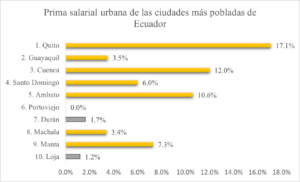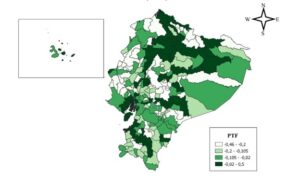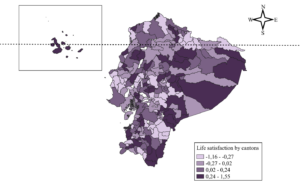This blog is part of the “Latin American Perspectives in Regional Studies” series and was published in both Spanish and English.
Cities have tremendous advantages in terms of access to services, job opportunities, production inputs and knowledge diffusion. The influence of cities on people development should take into account two aspects: pecuniary and non-pecuniary effects. This article sums up three of my research works in this respect, focusing on Ecuador.

Pecuniary effects are related to monetary income and productivity whereas non-pecuniary effects are related to subjective welfare. Workers that locate in big and densely populated cities can earn higher wages than in smaller cities. This wage advantage of big cities is called urban wage premium. In Ecuador, workers employed in metropolises earn 9.8% more than workers in small cities. The difference is 7% when comparing wages of workers of big cities and those in small cities.
No statistical difference exists between wages in medium-sized cities and small cities implying that workers should move to cities with a population higher than 234000 inhabitants to obtain the urban wage premium. However, not all big cities provide an urban wage premium, as shown in Figure 1. Guayaquil, despite of being the most populated city, does not provide the largest urban wage premium. Likewise, wages in Portoviejo are not higher with respect to small cities. In these cities, as well as in cities in other developing countries, there are serious problems of crime, insecurity, poverty, slums and informality that could be dissuasive factors to benefit from the urban wage premium.

Figure 1. Urban wage premium of most populated cities in Ecuador.
If wages are not higher in some big cities the question of whether firms are more productive in bigger cities remains important. In Guevara-Rosero (2021), we analyze the total factor productivity of manufacturing microfirms of Ecuador and obtains a ranking of cantons where microfirms are more and less productive. As shown in Figure 2, cantons leading this ranking are Santa Cruz, Francisco de Orellana, Antonio Ante, Quito and Zaruma. Cantons in the bottom of the ranking are La Mana, Arajuno, Chambo, Saquisili and Sucre.
“The cantonal productivity ranking results show intermediate cities or even small cities in the first positions…In intermediate and small cantons, firms have more room to grow in terms of productivity since those cities do not reach yet their technological frontier”. An important policy implication is that the budget allocation should consider, apart from the size of cities, the capacity of cities to improve the productivity of firms. In this case, intermediate cities should receive more resources and their physical endowments must be improved.

Figure 2. Total factor productivity of manufacturing companies by canton (2010).
Until now, we have seen that cities influence on pecuniary aspects such as wages of workers and productivity of firms. Let us analyze the effects of cities on the life satisfaction of people. In Guevara-Rosero (2022), a ranking of cantons where people are most satisfied and less satisfied with their lives is obtained. As shown in Figure 3, there are 52 cantons which are above the mean and 43 cantons below it; the remaining 115 cantons are not significantly different from the mean.
The cantons with the highest level of life satisfaction are San Cristobal, Isabela and Santa Cruz, which are all the cantons of the Galapagos region. Surprisingly, the metropolitan cities of Quito, Guayaquil and Cuenca are not ranked in the first positions, instead they are in the 108th, 119th and 77th positions, respectively. This indicates that big cities, in spite of providing basic infrastructure, services and amenities, could cause discomfort on the population due to congestion.
Among the cities with the lowest levels of life satisfaction, we have small cities such as Gonzalo Pizarro, Cascales Putumayo, Paján, Puebloviejo, Vinces, Muisne, Nabón, Penipe and Bolívar. The results show that basic infrastructure (water and utilities) is an important factor that leads to higher levels of life satisfaction. The policy implication is, then, to ensure that benefits of big civil engineering works such as roads, pipelines, irrigation, sewer systems, among others, reach not only urban but also rural residents of cantons.

Figure 3. Life satisfaction by cantons (2014-2015), random specific effects of the multilevel model.
To sum up, while cities are important drivers of economic development since they allow people (workers and firms) to have more and better opportunities, big cities do not constitute necessarily drivers of life satisfaction. This could be explained by congestion effects in big cities and the existence of severe issues such as crime and insecurity.
However, small cities are not happier places either. The policy implication is the need to reduce the unequal regional infrastructure provision, and in turn, improve the productive capacity of small and intermediate cities, by allocating economic resources to these places.

Carolina Guevara-Rosero, Ph.D. Department of Quantitative Economics, Escuela Politécnica Nacional, Ecuador.
Are you currently involved with regional research, policy, and development? The Regional Studies Association is accepting articles for their online blog. For more information, contact the Blog Editor at rsablog@regionalstudies.org.